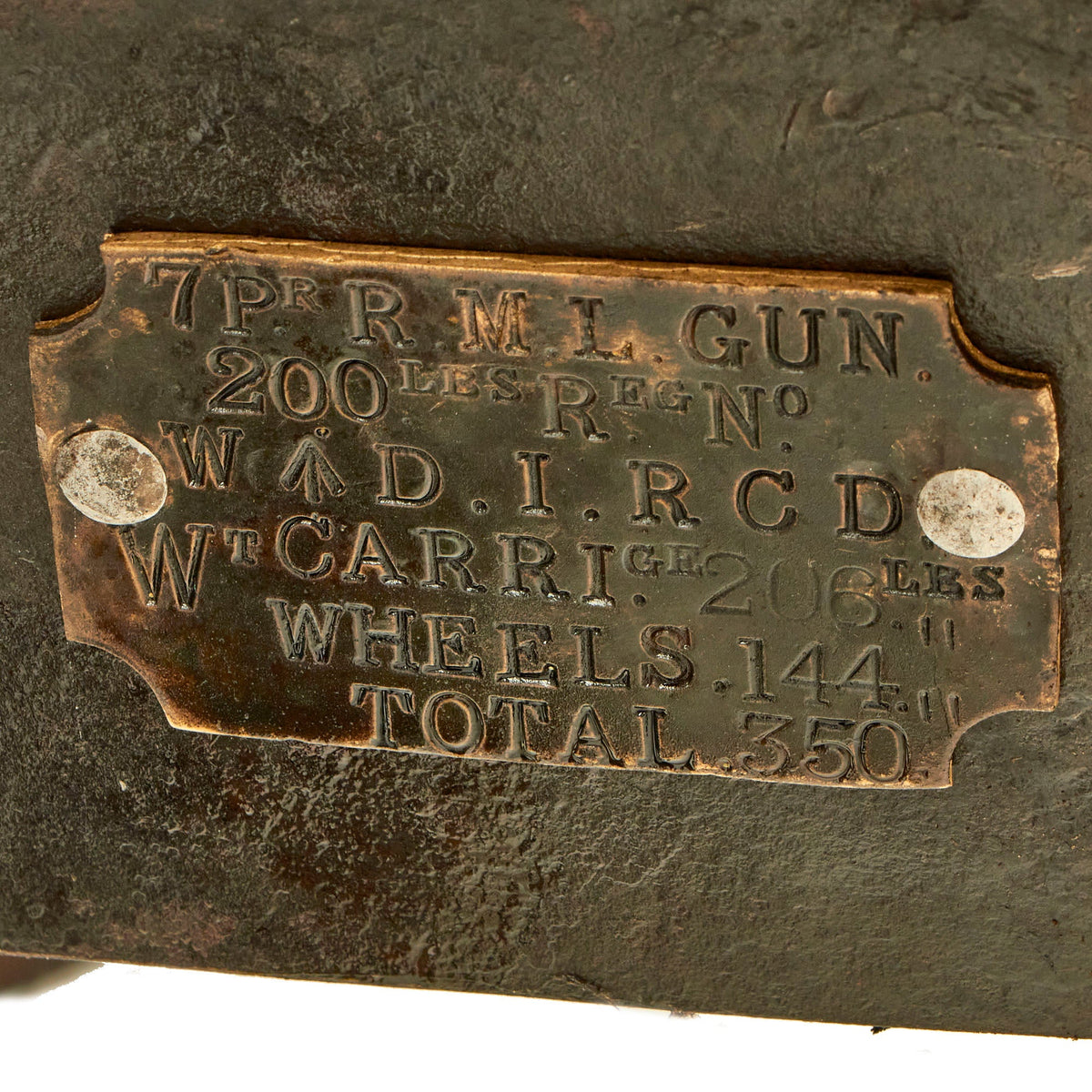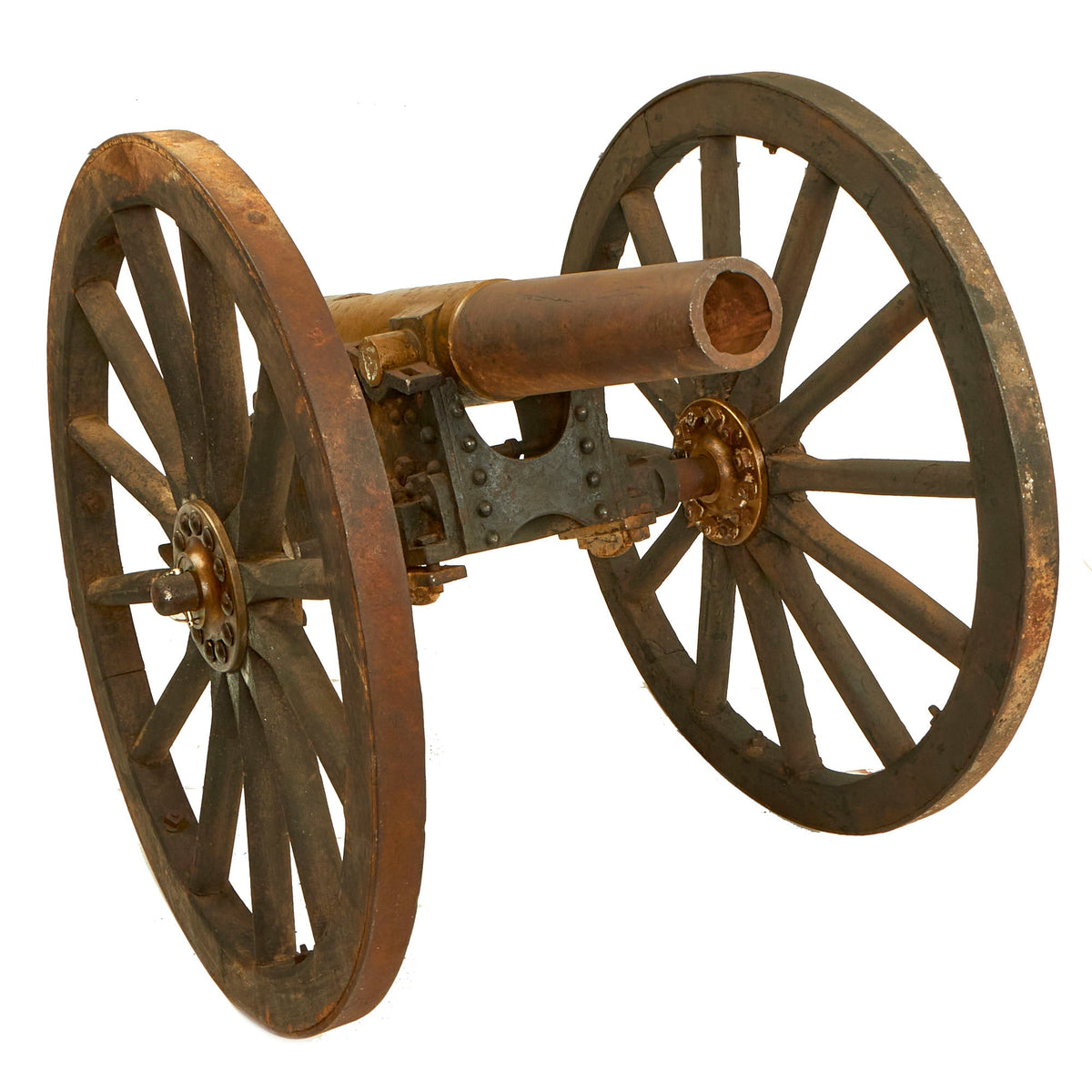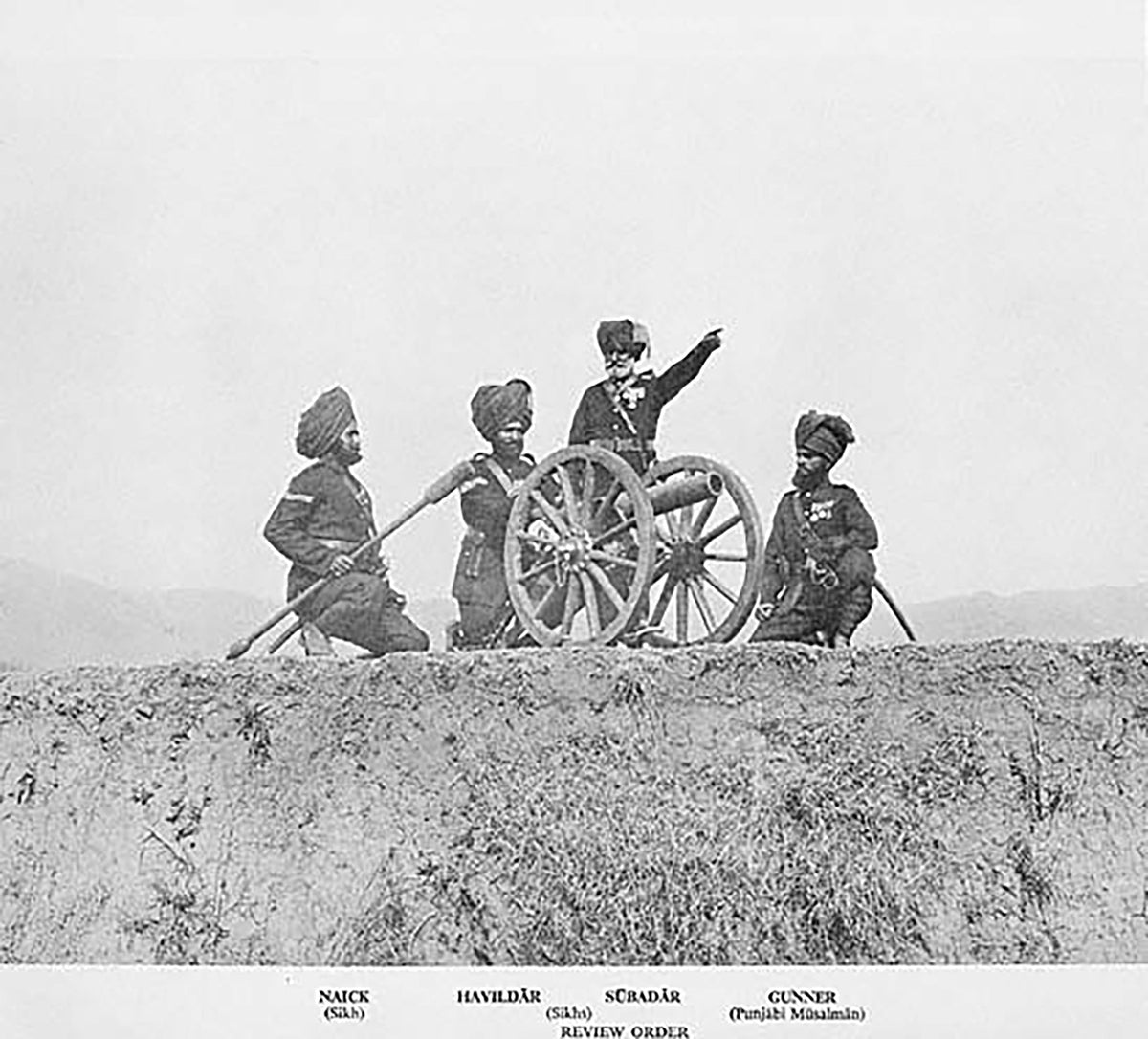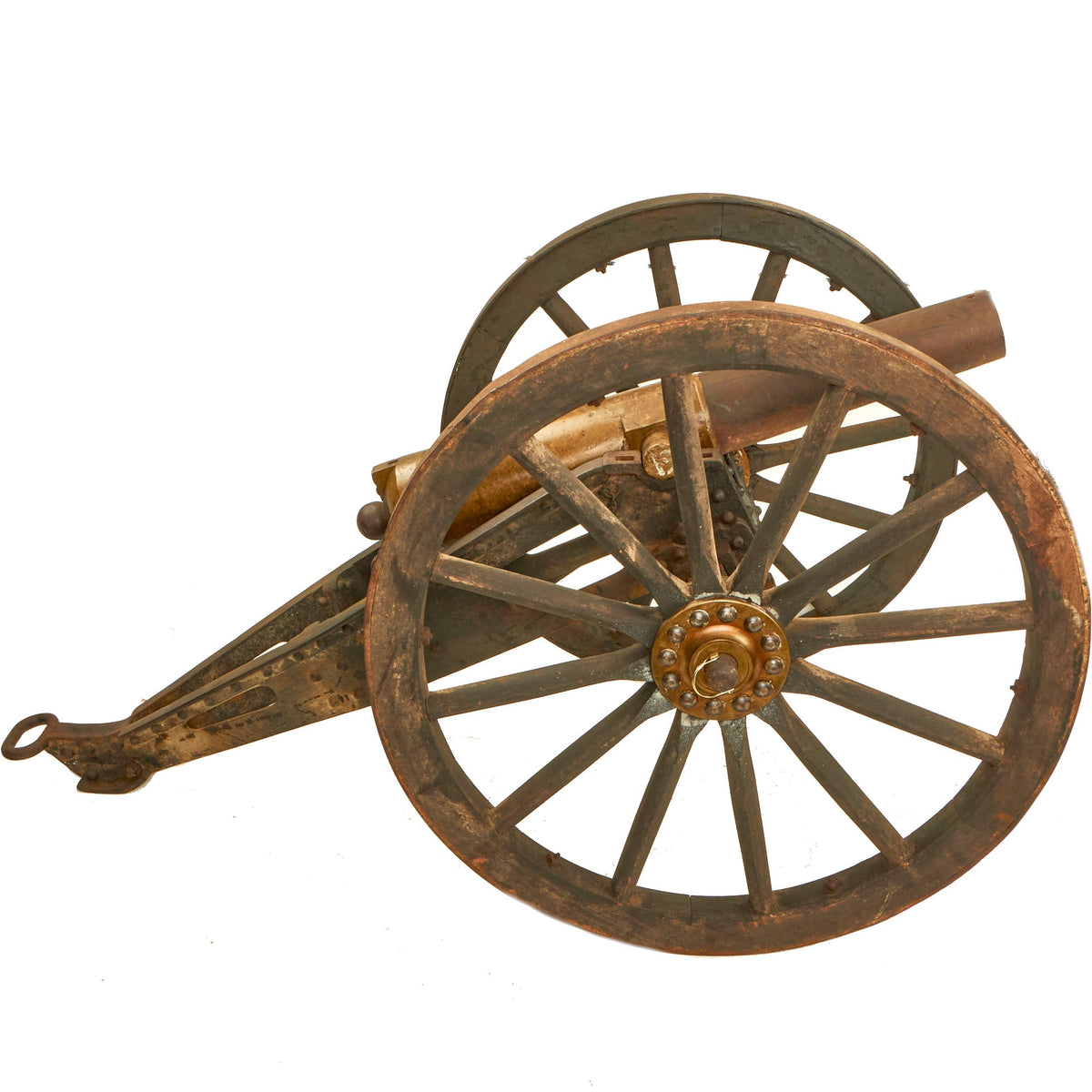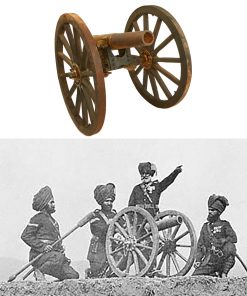Original British 7-Pounder 200 lbs. R.M.L. Mark IV Mountain Gun Original Items
$ 10.995,00 $ 2.748,75
Original Item: Only One available. Used by colonial British troops in India this is and The Ordnance RML (Rifled Muzzle Loading) 7-pounder Mk IV “Steel Gun” rifled muzzle loading mountain gun. 7-pounder referred to the approximate weight of the shell it fired.
The tube or barrel is unmarked, with the exception of Negari symbol and measures 36″ inches to the back to the barrel and 41″ to the back of the cascabel. With tapering steel barrel and bronze two stage barrel, mounted for sights (missing) and rifled with three deep grooves, the breech has no traces of original British markings. Knob-shaped bronze cascabel, with bronze sturdy trunnions. Original riveted iron cut-out carriage without elevation mechanism, one side with applied brass plaque stamped:
7 P.R R. M.L. GUN
2000 LBS R. EG No.
W/D I.R.C.D.
WT CARRIGE 206. LBS
WHEELS 144.
TOTAL 350.
Complete with original iron rimmed wood spoke wheels which are approximately 38″ in diameter and original brass hubs. Carriage measures 54″ in overall length, 10″ wide with a 35″ axle.
Curbside truck freight is included with purchase for locations within the US 48 states. For all other locations please contact us for an accurate freight quote prior to purchase.
Type: Mountain gun
Place of origin: United Kingdom
Service history
In service: 1873 – 1919
Used by
British Empire
India
Wars
Anglo-Zulu War
First Boer War
Second Boer War
Anglo-Aro War
Specifications
Mass: 200 lb (91 kg) barrel
Barrel length: 3 ft (0.91 m)
Shell
7 lb 11 oz (3.5 kg) (shrapnel)
7 lb 4 oz (3.3 kg) (common)
12 lb 4 oz (5.6 kg) (double)
Caliber 3 in (76 mm)
History
Development began in 1864 to replace the RBL 6-pounder 2.5-inch (64 mm) gun of 3 long hundredweight (340 lb; 150 kg), which had proved too heavy for a mountain gun. Several Mks of 7-pounder RML of 2 long hundredweight (220 lb; 100 kg) were tried in 1865 by boring out and rifling old SBML bronze guns, but were still too heavy.
Several Mks of new steel barrels (the first British all-steel gun, hence the name “Steel Gun”) were then produced of 190 lb (86 kg) and 150 lb (68 kg) but were not considered powerful enough.
Mk IV of 200 lb (91 kg) with a longer bore was settled on for production in 1873.
It was superseded by the RML 2.5-inch Mountain Gun from 1879.
Combat use
It could be assembled and a round loaded in 20 seconds. Its common shell was considered ineffective. To give it a high angle capability, a double shell was produced of increased length and containing a larger bursting charge. This was fired with a reduced charge, but the low muzzle velocity did not always arm the fuze, or prevent the over-long projectile from somersaulting. Shell rotation was effected by studs on the body of the shell. Elevation was by quoin or wedge and by screw.
Anglo-Zulu War 1879
Britain deployed several guns mounted on Colonial (or “Kaffraria”) carriages: light field gun type carriages with larger wider-spaced wheels suited for being horse-drawn across long grass. Two of these guns deployed as field guns of the N/5th Brigade, Royal Field Artillery were lost in the disastrous Battle of Isandlwana.[4][5]Second Anglo-Afghan War
Titled “Dignity & Impudence” for stereotypic personality traits of elephants and mules respectively, this photograph by John Burke (photographer) shows an elephant and mule battery during the Second Anglo-Afghan War. The mule team would have hauled supplies or towed the small field gun, while the elephants towed the larger gun. The gun appears to be a Rifled Muzzle Loader (RML) 7-pounder mountain gun. The men in the photograph are a mix of British soldiers and Indian sepoys. The group kneeling around the smaller, muzzle-loaded field gun is preparing to fire after the soldier at front left has used the ramrod to jam the charge down into the gun. The gun at right, towed by elephants, appears to be a Rifled breech loader (RBL) 40-pounder Armstrong (RBL 40-pounder Armstrong gun)
An RML 7-pounder Mountain Gun appears to be present in a photograph by John Burke (photographer) from the Second Anglo-Afghan War (November 1878 – September 1880). The war began when Great Britain, fearful of what it saw as growing Russian influence in Afghanistan, invaded the country from British India. The first phase of the war ended in May 1879 with the Treaty of Gandamak, which permitted the Afghans to maintain internal sovereignty but forced them to cede control over their foreign policy to the British. Fighting resumed in September 1879, after an anti-British uprising in Kabul, and finally concluded in September 1880 with the decisive Battle of Kandahar.[6]First Boer War 1880–1881
Britain deployed 4 guns mounted on standard small mountain carriages during the war.
War of the Golden Stool 1900
The West African Frontier Force fielded a number of guns in the War of the Golden Stool, their use being fairly heavily referenced by Willcocks, Armitage and Montanaro in their books on the campaign.Bartlett also references the Central African Regiment having a battery of 7-pounder guns attached to A Company in 1898, with the Central African Regiment taking part in the war.
Second Boer War 1899–1902
Boers with guns on mountain carriages captured at Kraaipan at the beginning of the war
The gun was employed mounted on armored trains and used by local militia forces early in the war.
It was also employed mounted on normal field carriages with larger wheels which increased mobility in the long grass and allowed it to be towed by horses.
Anglo-Aro War
Column No. 4 of The British assembled Aro Field Force deployed one 7-pounder gun during the battles in and around Arochukwu.
Surviving examples
Today, several examples of the guns still exist around the world :
– Regional Military Training Center in Darulaman Garrison, Kabul. The garrison is near the palaces, and south of the Bala Hissar where the British had their headquarters during the Anglo-Afghan wars.
– A gun at Royal Armoury, Fort Nelson, UK
– Royal Artillery Museum, London
– South African National Museum of Military History, Johannesburg, South Africa
Fast Shipping with Professional Packaging
Thanks to our longstanding association with UPS FedEx DHL, and other major international carriers, we are able to provide a range of shipping options. Our warehouse staff is expertly trained and will wrap your products according to our exact and precise specifications. Prior to shipping, your goods will be thoroughly examined and securely secured. We ship to thousands clients each day across multiple countries. This shows how we're dedicated to be the largest retailer on the internet. Warehouses and distribution centres can be located throughout Europe as well as the USA.
Note: Orders with more than one item will be assigned a processing date depending on the item.
Before shipping before shipping, we'll conduct a thorough inspection of the items you have ordered. Today, the majority of orders will be delivered within 48 hours. The delivery time will be between 3-7 days.
Returns
The stock is dynamic and we cannot completely manage it because multiple stakeholders are involved, including our factory and warehouse. So the actual stock may alter at any time. It's possible that you may not receive your order once the order has been made.
Our policy is valid for a period of 30 days. If you don't receive the product within 30 days, we are not able to issue a refund or an exchange.
You can only return an item if it is unused and in the same state as the day you received it. You must have the item in its original packaging.
Related products
Uncategorized
Uncategorized
Uncategorized
Uncategorized
Uncategorized
Uncategorized
Uncategorized
Uncategorized
Armored Burgonet Helmet & Polearm from Scottish Castle Leith Hall Circa 1700 Original Items
Uncategorized
Uncategorized
Uncategorized
Uncategorized
Armoured Fighting Vehicles of the World: AFVs of World War One (Hardcover Book) New Made Items
Uncategorized
Uncategorized
Band of Brothers ORIGINAL GERMAN WWII Le. F.H. 18 10.5cm ARTILLERY PIECE Original Items
Uncategorized
Uncategorized


